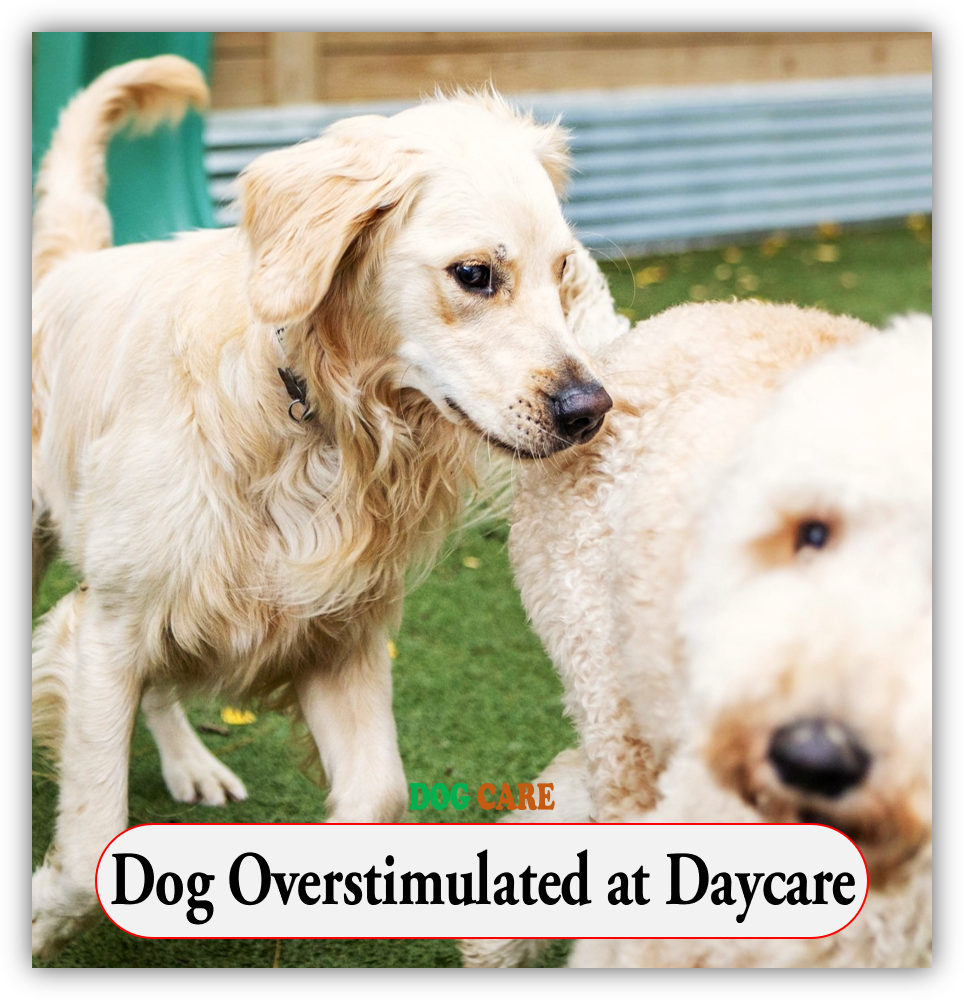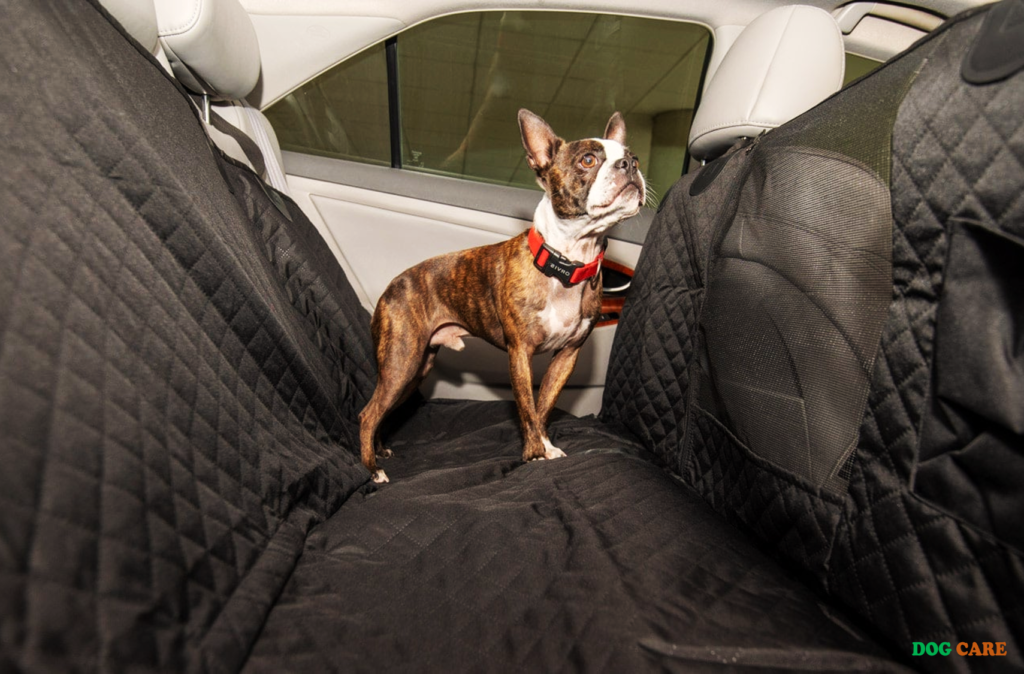Dog Overstimulated at Daycare : A dog may become overstimulated at daycare due to excessive sensory input and excitement, which can lead to behavioral issues. Daycare can be a fun and enriching experience for dogs, providing them with socialization and exercise.
However, some dogs may become overstimulated in this environment, which can result in negative behaviors. Overstimulation occurs when a dog’s senses are overwhelmed by excessive stimuli, such as loud noises, lively play, and constant activity. This can lead to heightened arousal levels, anxiety, and difficulty focusing.
It is important for dog owners and daycare providers to recognize and manage overstimulation to ensure a safe and positive experience for dogs. We will explore common signs of overstimulation in dogs at daycare and discuss effective strategies to prevent and address this issue.

Recognizing Signs Of Overstimulation
When our furry friends attend a dog daycare, they get the opportunity to socialize, play, and burn off their excess energy. However, just like humans, dogs can also become overstimulated in this high-energy environment. As responsible pet parents, it’s crucial for us to recognize the signs of overstimulation in our dogs to ensure their well-being and happiness. In this article, we will explore the behavioral and physical indicators that can help us identify when our dogs are overwhelmed at daycare.
Behavioral Indicators
Behavioral indicators can give us valuable insight into our dog’s mental state and help us understand when they are experiencing overstimulation. Keep an eye out for the following behavioral signs:
- Barking excessively
- Growling or snarling at other dogs or staff
- Chasing their tail obsessively
- Jumping excessively on people or objects
- Exhibiting sudden changes in behavior, such as becoming agitated or withdrawn
If you notice any of these behavioral indicators in your dog, it’s important to take action. Removing them from the overly stimulating environment and providing them with a calm and quiet space can help them relax and recover.
Physical Indicators
Physical indicators can also give us valuable clues about our dog’s overall well-being and level of stimulation. Keep an eye out for the following physical signs:
- Rapid and shallow breathing
- Trembling or shaking
- Excessive panting
- Dilated pupils
- Inability to settle down or relax
These physical indicators can signal that your dog is feeling overwhelmed and overstimulated. If you notice any of these signs, it’s essential to remove them from the high-energy environment and provide them with a quiet and calming space to decompress.
By recognizing these behavioral and physical signs of overstimulation, we can take the necessary steps to ensure our beloved dogs have a positive and stress-free daycare experience.
Creating A Calm Environment
Dogs can easily become overstimulated in a daycare environment due to the constant activity, noise, and interaction with other dogs. To ensure their well-being and prevent stress or anxiety, it’s crucial to create a calm and peaceful atmosphere that promotes relaxation. By providing quiet spaces and implementing routines, you can help your furry friends find balance and serenity in a daycare setting.
Providing Quiet Spaces
Dogs, just like humans, sometimes need a break from socializing and stimulation. Having dedicated quiet spaces in the daycare facility can offer a retreat for dogs who are feeling overwhelmed. These spaces should be away from noisy areas and provide a peaceful environment for the dogs to relax and recharge.
Some ways to create quiet spaces for dogs include:
- Designating a separate room or area specifically for quiet time
- Using comfortable mats or beds for dogs to rest on
- Adding soothing background music or white noise to mask external sounds
Implementing Routines
Dogs thrive on routine and predictability, as it brings a sense of security and stability to their day. In a daycare environment, implementing consistent routines can help dogs feel more at ease and prevent overstimulation.
Here are a few ways to establish routines in a daycare setting:
- Regular feeding and watering schedule to ensure dogs are nourished and hydrated throughout the day
- Set times for rest or nap periods, allowing dogs to recharge and relax
- Scheduled playtime sessions that are structured and supervised, preventing overexertion
By adhering to these routines, daycare facilities can provide a balanced day for the dogs, enabling them to enjoy socialization while avoiding excessive stimulation.
Managing Group Interactions
When it comes to a dog overstimulated at daycare, managing group interactions is crucial for their well-being. By closely monitoring play sessions and introducing structured activities, we can ensure the dogs have a positive and safe experience.
Monitoring Play Sessions
Monitoring play sessions is key to preventing overstimulation and potential conflicts. Here are some ways to keep a close eye on the dogs:
- Regularly check their body language and behavior for signs of stress or aggression.
- Have trained staff members stationed around the play area to intervene if necessary.
- Set up security cameras for continuous monitoring and quick response to any issues.
By actively monitoring play sessions, we can identify early warning signs and take appropriate measures to ensure the dogs remain calm and comfortable.
Introducing Structured Activities
Introducing structured activities helps redirect the dogs’ energy and focus while preventing overstimulation. Here are a few ideas:
- Create puzzle toys or treat-dispensing toys that engage their minds and keep them occupied.
- Implement training sessions where dogs can learn new commands and tricks, providing mental stimulation.
- Organize group walks or agility exercises to channel their energy in a structured environment.
Structured activities allow the dogs to participate in a controlled manner, reducing the risk of overstimulation and promoting a more balanced experience at daycare.
Implementing Rest Periods
Rest periods are crucial for dogs at daycare to prevent overstimulation and ensure their well-being. Without adequate rest, dogs can become exhausted, agitated, and may display disruptive behavior. By implementing regular nap times and using enrichment toys, daycare centers can create a calmer environment that promotes relaxation and rejuvenation.
Establishing Nap Times
To effectively implement rest periods, it is essential for daycare centers to establish designated nap times throughout the day. This allows dogs to recharge and recuperate from the excitement and activities of the daycare environment. During these designated times, the daycare staff should create a peaceful atmosphere by dimming the lights and minimizing noise levels.
Here’s a simple schedule to consider:
| Time | Activity |
|---|---|
| 10:00 AM | Nap Time |
| 2:00 PM | Nap Time |
| 5:00 PM | Nap Time |
By adhering to a consistent schedule, dogs will begin to anticipate these moments of rest, allowing them to relax and recharge before returning to play. It is important for daycare centers to understand that each dog may have unique needs, so it is crucial to observe their behavior and adjust the schedule accordingly if necessary.
Using Enrichment Toys
In addition to nap times, providing dogs with enrichment toys during rest periods can help keep them mentally stimulated while ensuring they remain calm and relaxed. Enrichment toys are specially designed to engage a dog’s senses and encourage problem-solving behaviors. Kong toys stuffed with treats or puzzle toys that dispense food are excellent options for keeping dogs entertained and focused during their down time.
Here are a few examples of popular enrichment toys:
- Snuffle mats
- Treat-dispensing balls
- Interactive puzzle toys
These toys are not only enjoyable for the dogs but also help alleviate any stress or anxiety they may feel during daycare. The mental stimulation they provide can tire dogs out in a positive way, ensuring they are ready for a nap when the time comes.
Implementing rest periods in a daycare setting is vital for the overall well-being of the dogs in attendance. By establishing nap times and utilizing enrichment toys, daycare centers can create a balanced environment that allows dogs to rest and recharge, resulting in happier, healthier pups ready to take on the day’s activities.
Effective Communication With Staff
Effective communication with staff is key when dealing with a dog who becomes overstimulated at daycare. By openly discussing the situation and sharing concerns, solutions can be found to ensure the well-being and comfort of the dog while maintaining a safe and enjoyable environment for all.
Effective Communication with Staff: Sharing Information Effective communication with the staff at a dog daycare facility is crucial in ensuring your pet’s well-being. By sharing information about your furry friend’s behavior, preferences, and any specific concerns, you can help the staff better understand and address their needs. Whether it’s a certain toy they love or a particular trigger that may cause overstimulation, providing these details can make a significant difference in your dog’s experience at daycare.
Openly discussing their routines, recent changes in behavior, and any medical conditions can help the staff tailor their care specifically for your pet. Communicating Concerns While dog daycare staff are experienced and attentive, it’s important for dog owners to effectively communicate any concerns they may have. If you notice signs of overstimulation or any discomfort exhibited by your pet after daycare visits, promptly bringing it to the attention of the staff can prevent further issues.
By communicating your concerns in a respectful and clear manner, you can work together with the staff to find solutions and prevent future overstimulation episodes. Regular and open dialogue with the daycare staff fosters a collaborative approach to address any issues or challenges your dog may face.
In the process of ensuring your dog’s comfort and safety, engaging in effective communication with the staff at the daycare facility plays a crucial role. Sharing relevant information about your pet’s preferences, routines, and any concerning behaviors can pave the way for personalized care. Meanwhile, communicating any concerns promptly and respectfully allows for immediate action, creating a supportive and proactive environment for your beloved companion. Remember, open lines of communication contribute to a positive daycare experience for your pet.

Frequently Asked Questions For Dog Overstimulated At Daycare
How Do I Calm My Dog Down At Daycare?
To calm your dog at daycare, provide a familiar item like a blanket or toy. Create a routine and stick to it. Use positive reinforcement and reward good behavior. Ensure the environment is stimulating but not overwhelming. Consult with daycare staff on any concerns or techniques.
What Does Overstimulation Look Like In Dogs?
Overstimulation in dogs can be recognized by excessive barking, hyperactivity, pacing, and restlessness. They may also exhibit destructive behavior, difficulty settling down, and increased aggression. It’s important to provide appropriate outlets for their energy and create a calm environment to prevent overstimulation.
Is It Stressful For Dogs To Go To Daycare?
Yes, it can be stressful for dogs to go to daycare. The unfamiliar environment and being around other dogs may cause anxiety.
How Do You Help An Overstimulated Dog?
To help an overstimulated dog, create a calm environment, remove triggers, and provide a designated safe space. Offer gentle physical touch, such as a massage or belly rubs. Use essential oils or calming aids for relaxation. Consult a professional for behavior modification techniques if needed.
Conclusion
Having a dog that becomes overstimulated at daycare can be a challenging situation. It is important to understand the signs of overstimulation and take steps to minimize stress for your furry friend. By maintaining a calm and safe environment, providing appropriate breaks, and working with daycare staff, you can help your dog have a positive and enjoyable experience at daycare.
Remember, each dog is unique, so finding the right balance of stimulation and rest is key to their well-being.


